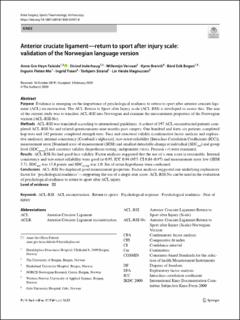| dc.contributor.author | Faleide, Anne Gro Heyn | |
| dc.contributor.author | Inderhaug, Eivind | |
| dc.contributor.author | Vervaat, Willemijn | |
| dc.contributor.author | Breivik, Kyrre | |
| dc.contributor.author | Bogen, Bård Erik | |
| dc.contributor.author | Mo, Ingunn Fleten | |
| dc.contributor.author | Trøan, Ingrid | |
| dc.contributor.author | Strand, Torbjørn | |
| dc.contributor.author | Magnussen, Liv Heide | |
| dc.date.accessioned | 2020-06-03T11:41:54Z | |
| dc.date.available | 2020-06-03T11:41:54Z | |
| dc.date.created | 2020-04-28T12:11:28Z | |
| dc.date.issued | 2020 | |
| dc.identifier.citation | Faleide, A. G. H., Inderhaug, E., Vervaat, W., Breivik, K., Bogen, B. E., Mo, I. F., . . . Magnussen, L. H. (2020). Anterior cruciate ligament—return to sport after injury scale: validation of the Norwegian language version. Knee Surgery, Sports Traumatology, Arthroscopy. | en_US |
| dc.identifier.issn | 0942-2056 | |
| dc.identifier.uri | https://hdl.handle.net/11250/2656366 | |
| dc.description.abstract | Purpose
Evidence is emerging on the importance of psychological readiness to return to sport after anterior cruciate ligament (ACL) reconstruction. The ACL-Return to Sport after Injury scale (ACL-RSI) is developed to assess this. The aim of the current study was to translate ACL-RSI into Norwegian and examine the measurement properties of the Norwegian version (ACL-RSI-No).
Methods
ACL-RSI was translated according to international guidelines. A cohort of 197 ACL-reconstructed patients completed ACL-RSI-No and related questionnaires nine months post-surgery. One hundred and forty-six patients completed hop tests and 142 patients completed strength tests. Face and structural validity (confirmative factor analysis and explorative analyses), internal consistency [Cronbach’s alpha (α)], test–retest reliability [Intraclass Correlation Coefficients (ICC)], measurement error [Standard error of measurement (SEM) and smallest detectable change at individual (SDCind) and group level (SDCgroup)] and construct validity (hypotheses testing; independent t tests, Pearson’s r) were examined.
Results
ACL-RSI-No had good face validity. Factor analyses suggested that the use of a sum score is reasonable. Internal consistency and test–retest reliability were good (α 0.95, ICC 0.94 (95% CI 0.84–0.97) and measurement error low (SEM 5.7). SDCind was 15.8 points and SDCgroup was 2.0. Six of seven hypotheses were confirmed.
Conclusions
ACL-RSI-No displayed good measurement properties. Factor analyses suggested one underlying explanatory factor for “psychological readiness”—supporting the use of a single sum score. ACL-RSI-No can be used in the evaluation of psychological readiness to return to sport after ACL injury. | en_US |
| dc.language.iso | eng | en_US |
| dc.publisher | Springer | en_US |
| dc.rights | Navngivelse 4.0 Internasjonal | * |
| dc.rights.uri | http://creativecommons.org/licenses/by/4.0/deed.no | * |
| dc.subject | ACL-RSI | en_US |
| dc.subject | ACL reconstruction | en_US |
| dc.subject | return to sports | en_US |
| dc.subject | psychological response | en_US |
| dc.subject | psychological readiness | en_US |
| dc.subject | fear of injury | en_US |
| dc.title | Anterior cruciate ligament—return to sport after injury scale: validation of the Norwegian language version | en_US |
| dc.type | Peer reviewed | en_US |
| dc.type | Journal article | en_US |
| dc.description.version | publishedVersion | en_US |
| dc.rights.holder | © The Author(s) 2020 | en_US |
| dc.subject.nsi | VDP::Medisinske Fag: 700::Idrettsmedisinske fag: 850 | en_US |
| dc.source.journal | Knee Surgery, Sports Traumatology, Arthroscopy | en_US |
| dc.identifier.doi | 10.1007/s00167-020-05901-0 | |
| dc.identifier.cristin | 1808446 | |
| cristin.ispublished | true | |
| cristin.fulltext | original | |
| cristin.qualitycode | 1 | |

